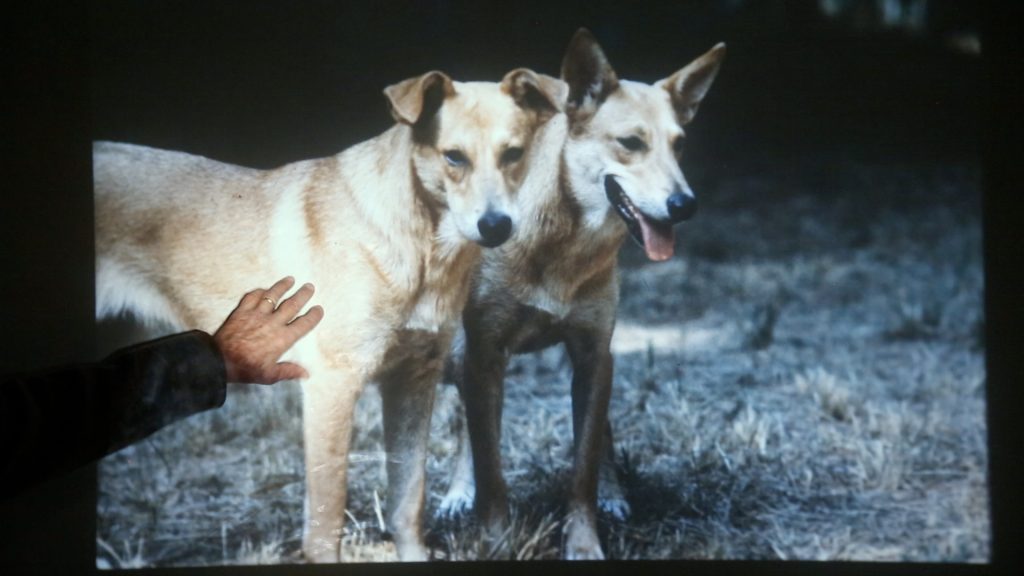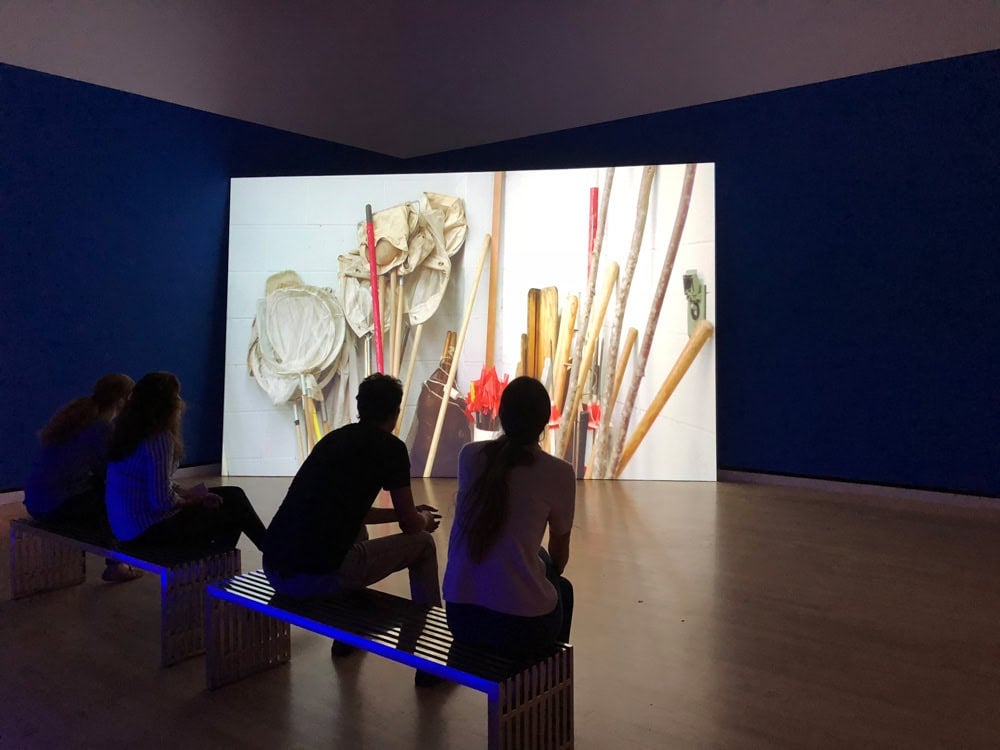
Images of wild dogs encircle us in the uranium yellow gallery. They appear to dash behind us, barking and grunting — only several yards away, judging from the sound of their paws through the crisp underbrush. Moments later, a few golden dogs gallop and amble as they appear first on one screen, and then the next, of the large televisions hung on steel poles throughout the gallery like security monitors. We may try to follow the dogs’ movements through both sight and sound, but they are elusive. The sickly gold of the walls bathes us with an ominous sense of protective distance — but from what, exactly?
In this observation room of sorts, where visitors encountered the little-understood Carolina dog, artist Erin Johnson deftly placed the viewer in the role of a researcher operating simultaneously in the field and in the lab. Certain questions emerge: What are these dogs? Where are they? What are they doing out here? As visitors watched for the dogs and grappled with the unknowns—or attempted to reconcile them with the wall text—the works in Johnson’s recent solo exhibition Heavy Water, on view at the Telfair Museums’ Jepson Center in Savannah through March 3, slowly provided complex yet incomplete answers. Comprised of multi-channel video and sound installations, Johnson’s exhibition wove together ecological, historical, and mythological narratives from the Savannah River Site (SRS), a fraught nuclear facility that covers over 300 square miles abutting the Georgia border along the Savannah River.
In the other gallery, a two-channel video installation glowed within a dark, marine blue chamber that suggests the feeling of moving deeper into a nuclear facility, conjuring the photoluminescent blue caused by electromagnetic radiation of deuterium oxide—an isotope of hydrogen known as “heavy water,” due to the weight of an extra neutron per molecule. D2O is used in nuclear fission and creates tritium, a radioactive isotope currently produced by the SRS for nuclear weapons. Johnson’s videos employed a documentary style with footage that includes her own documentation of the Carolina dog—here comprised of intimate close-ups captured on a lab table—and meditative shots of the Savannah River Site’s Brutalist government buildings and lush, marshy riverscapes taken from just beyond the perimeter of the site. Several shots of nuclear reactor cores—featuring the cool blue glow of Cherenkov radiation they emit—appeared as final punctuation, mesmerizing and terrifying as ghosts.

What contextualizes our understanding of these supposedly natural landscapes and the animals that inhabit them? The loudest and most unsettling voice in the curious narrative comes from Dr. I. Lehr Brisbin, an ecologist who studies radiation in animals within the SRS. In a slide presentation, Brisbin theorizes that the Carolina dog, which resembles a dingo, is a wild descendent of Asiatic dogs that might have migrated across the Bering land bridge. It’s clear that Johnson is heavily suspicious of both Brisbin and those in charge of the SRS: the camerawork throughout Heavy Water intentionally obfuscates our view of the ecologist — as if to take away his power — while the lens, when aimed at the Carolina dog, implies a gentle petting hand. In Brisbin’s mythology of the dogs — he cites as a kind of proof the tales of Romulus and Remus as well as The Jungle Book — he submits that the Superfund site has served as a lucky sanctuary for these dogs and a buffer from radioactive contamination for the past seventy years.
This “sanctuary” was built to manufacture materials for nuclear weapons in 1951 after the United States government forcibly evicted 6,000 inhabitants from the poor and rural communities that lived there, many of them Black farmers and sharecroppers, to make way for the site. In addition to significant displacement, an article from The Post and Courier names a number of health and safety problems stemming from the site, including groundwater and soil contamination from radioactive dirt buried in cardboard boxes, unusually high instances of cancer and other radiation-related illnesses among workers, and dozens of serious incidents that were kept secret for as long as three decades. While the site no longer has operating reactors, it is the only producer of tritium in the U.S. and contains radioactive materials like plutonium-239, which has a half life of 24,000 years—meaning it would take 240,000 years for it to be rendered harmless.

In her introduction to Heavy Water, Johnson included text from a hand-lettered sign posted at the time of eviction in the now-defunct town of Ellenton, South Carolina: “It is hard to understand why our town must be destroyed to make a bomb that will destroy someone else’s town that they love as much as we love ours.” Johnson is an artist who negotiates the relationships between the body and the land as well as those between the body and historical narrative. Heavy Water navigated the impossibly abstract timescale of nuclear toxicity by fixing our view on the Carolina dog and asking us to consider the complexities of its protection. In positioning the viewer as researcher—a figure tasked with gathering multiple narratives, accounts, and facts from which one must decide the price of progress—Johnson advocated for viewers’ agency and implored our action.
In an era of weaponized storytelling, frail nuclear agreements, and unprecedented disregard for international norms, Johnson sharply criticizes forces that would prioritize war and profit over protecting people and the earth. Yet she still finds some common ground with those she also critiques. At the end of the recording of his lecture included in the exhibition, the ecologist Dr. Brisbin says, “The animals teach us to answer questions that we haven’t yet learned to ask.” We sense that, for wildly different reasons, Johnson might agree.
Erin Johnson‘s solo exhibition Heavy Water was on view at the Telfair Museums’ Jepson Center in Savannah, Georgia, through March 3.




